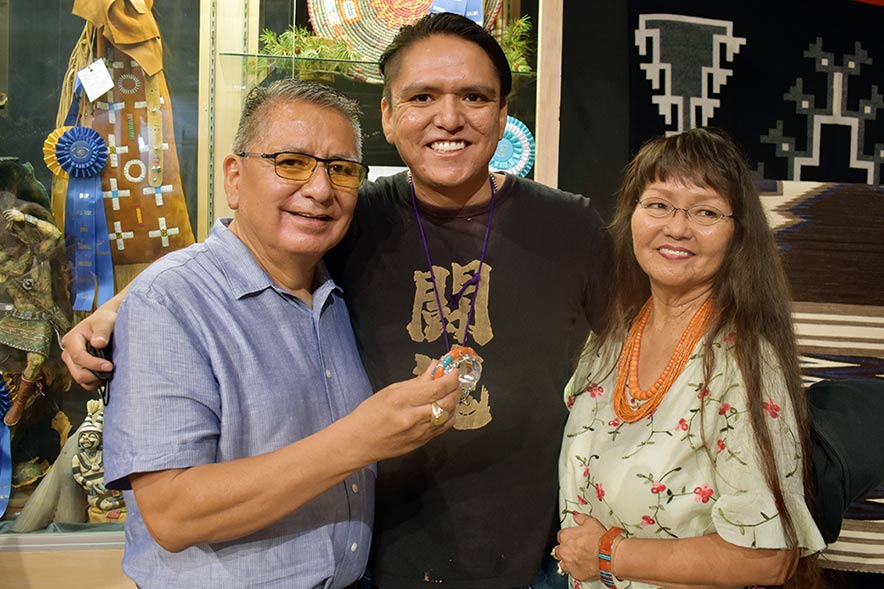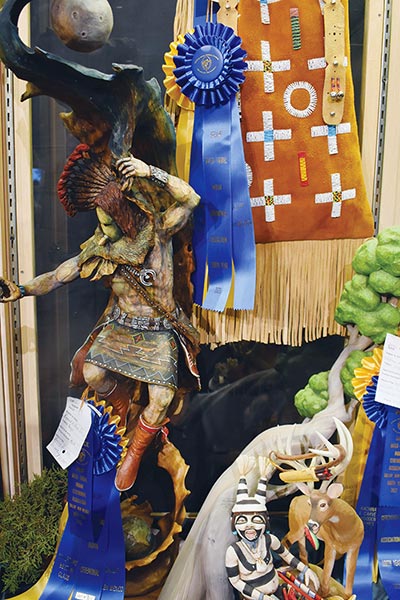
Diné artists win big: Ceremonial art exhibit brings record crowds, sales, awards

Navajo Times | Rima Krisst
Best of show winner Raymond Yazzie with his son Christopher Yazzie and wife Colina Yazzie at the Ceremonial fine art exhibit opening night preview on Aug. 10 at Red Rock Park.
GALLUP
This year’s Gallup Inter-Tribal Ceremonial fine art exhibit brought in a record 1,400 entries and garnered $95,000 in sales, said the show’s coordinator Joyce Graves, who has been volunteering with Ceremonial for 30 years.
“I’m so excited that not only did we have a great Ceremonial this year for the 100th, but we broke our record in sales,” said Graves.

Navajo Times | Rima Krisst
In the Ceremonial fine art exhibit best of class winners display case, Raymond Chee’s sculpture “Blessing from the Universe,” Leslie Bitsie Jr.’s “Old Time Medicine Man Saddle Horn Bag,” and Robert Albert’s Koshare with Deer “Snooze You Lose” carving.
The art exhibit also drew record crowds, starting with the opening night art preview on Wednesday, Aug. 10.
“It was like it was in the old days,” said Graves. “The parking lot was packed. It was phenomenal. It was a great celebration.”
Thanks to the contributions of “Centennial Club” donors, $100,000 was set aside for art awards this year with $11,950 awarded to the best of show winner, the largest prize ever paid to a Ceremonial artist.
That honor went to world renowned silversmith/lapidarist Raymond Yazzie for his classic silver and gold “Heritage II” bracelet, inlayed with turquoise, coral and gemstones, valued at $98,000.
“It was a big surprise because I wasn’t expecting the big prize,” said Yazzie.
Yazzie said he won his first best of show for a collaborative piece when he was just 14 years old in the 1970s so he’s literally grown up with Ceremonial.
“That’s where I really got my start,” he said. “I’m going on 54 years of being a silversmith and a lapidarist. This is my fourth best of show and it’s really special because it’s the 100th anniversary.”
Under the tutelage of his mother, silversmith and weaver Elsie Yazzie, Raymond Yazzie said he started making jewelry when he was 8 years old.
“She was my biggest teacher and my biggest mentor,” he said. “A lot of these things that I do, I still have her in mind.”
‘The heartbeat of Gallup’
Long-time art dealer/trader Cindy Tanner told Navajo Times that the Ceremonial is the “heartbeat of Gallup” and the fine art exhibit is one of the most intimate shows you can attend.
“Everyone is attainable,” she said. “You can talk to the artists. You can talk to volunteers who’ve been here for years and years. It’s a passion.”
Tanner is Gallup born and raised and own’s Tanner Indian Arts with her husband Joe Tanner and daughter Emerald Tanner.
“I’ve been involved in Ceremonial all my life,” said Tanner. “I can’t tell you how thrilling it is to see this 100th come through and it’s all because of the volunteers from Gallup, New Mexico.”
Tanner affectionately said best of show winner Raymond Yazzie will always be “a Ceremonial baby.”
“Look what he’s done!” she said. “He’s been around the world with his jewelry and it is wearable art, but he never forgets Ceremonial.”
Tanner said the art show offers a level playing field, where up-and-coming artists can compete with well-known, established artists.
“Everything that is entered – everyone has a chance to vie for best of show,” she said. “Anyone who wants to enter can enter. It’s fair game. It’s the most prestigious art show there is in the country.”
‘Spirit and excitement’
In addition to Yazzie, who also won best in class for lapidary arts, there were 9 best of class winners, many of whom are world class artists in their own right and have been participating in Ceremonial for decades.
A panel of 25 judges, made up of seasoned art dealers, gallery owners and artists juried the competition.
Jeweler/silversmith Lyndon Tsosie took best in class for metalsmithing with his elaborate stamped dinner set with flatware called “So’Bitáádéé Iina Hajinee’/Origin of Life Through Light” that depicts the northern and southern star constellations with designs drawn from Navajo oral stories.
“When you look at it, it is very contemporary, but the design is also very traditional,” said Tsosie. “It has a very powerful meaning in who we are as Navajo people in a contemporary form.”
Tsosie said on the occasion of the 100th anniversary, many artists, traders and galleries entered “magnificent” pieces into the competition.
“It’s a competition where you want to win because It’s one of the most prestigious awards,” he said. “It’s a good feeling to know that I can compete among the best in American Indian art. I love that.”
LeChee artist Raymond Chee Sr., who won best of class for sculpture for his elaborate Yei’Bi’Chei carving “Blessing from the Universe,” said the inspiration for many of his pieces comes from his dreams.
Chee said was honored to be recognized for the talent and gifts given to him by the Creator and to be able to share Diné stories and teachings through his work.
“It means a lot,” he said. “It’s something I can share with the younger kids who are interested.”
Chee said teaching is always a big part of his art, especially for those who want to hang on to their culture and traditional ways.
Pinon Chapter artist Johnson Yazzie, who won best of class for paintings for his portrait of an elder, “AM 660 Afternoon,” said it’s the spirit and excitement of the event that keeps him coming back to the Ceremonial.
“This is always my favorite show,” said Yazzie. “Ever since I was a kid, something about the art just touched me and I wanted to be a part of it. It’s very emotional and motivational.”
He said now it’s a privilege to have his work displayed among the other award-winning diversified artisans in the competition.
“I always wanted to be part of the mystique and now I’m enjoying it and I’m living the excitement,” said Yazzie.
‘Aspire to greatness’
Moenkopi artist Robert Albert, known for combining humor with tradition, won best of class for carved wooden figures for his Hopi Koshare scene “Snooze, You Lose” and said he’s been participating in Ceremonial for over 30 years.
“I was very pleased to walk into the preview night and see that my carving had won best of class and was placed among some of the most well-known artists in the Southwest,” said Albert.
He said through Ceremonial, he’s gotten to know many of the other best of class winners over the years.
“It’s a very nice friendship that we all share and we all encourage one another and feed off of each other’s ideas,” said Albert. “It’s a privilege and honor to be among them.”
Albert also encouraged the younger generations to carry on their traditions and “aspire to greatness.”
Tohatchi beadwork artist Leslie Bitsie Jr., who won best of class for tribal arts, said the design and inspiration for his “Old Time Navajo Medicine Man Saddle Horn Bag,” came from his late mother Alice Bitsie.
“She told me the stories about how she saw beadwork and the old medicine people, and how they utilized their leather bags,” he said. “The way she described it is how I made it.”
Bitsie said when he saw his bag in the best of class display case at the Ceremonial fine art exhibit, he felt happy, thankful and humbled.
“I was so excited to see the Rosette ribbons with the 100th year imprinted,” said Bitsie. “I could see my mom in my mind and I could still hear her voice and her telling the stories.”
Bitsie said it’s amazing that he gets to be a part of the great artistry of the past century.
“It felt validating that I’m making something beautiful and that there’s going to be beauty in the world and that I get a chance to help that beauty keep going,” he said.
San Ildefonso Pueblo potter Russell Sanchez said he was thrilled to win the best of class for pottery for his checkerboard turquoise on black style piece “Winter Blue Corn.”
“I take the old and bring it into the now,” he said. “That design comes from a hundred years ago, but I made it a little more modern and contemporary by inlaying it with the turquoise dots, which represents corn.”
All the more his win was especially meaningful because he remembers generations of his relatives going to the Inter-Tribal Ceremonial in decades past, he said.
“I really feel special about winning this year because of the history with a lot of people from San Ildefonso going to Gallup and participating,” said Sanchez.
‘Creating beauty’
Weaver Tyler Glasses Jr., said to win best of class in textiles for his weaving “Poncho for Days” at Centennial art show is an “out of this world” feeling.
“I think when weaving, we start a textile with the goal of creating beauty,” said Glasses. “So, every entry is a one-of-a-kind masterpiece. When you get a ribbon, it’s like a cherry on top of the weaving experience.”
Monument Valley basket-weaver Sally Black won best in class for baskets with her “Fire God” basket that symbolizes renewal.
“I feel great,” said Black. “It made me happy that I won again. Every time when I see a ribbon like that it keeps me going.”
She said all of the successful artists who won the top award have one thing in common, and that is they’ve put in a lot of work.
“You worked for it, you earned it,” said Black. “It’s hard. It takes a long time to get to that level.”
Fourteen-year-old Mary Helen Brown won the best in class youth award for a silver and gold concha belt titled “Beauty Above Me.”
“It’s based off what I can see at night, because we live so far away from life that you can see all of the stars,” said Brown, who hails from Mariano Lake.
The articulate youngster, who is a protégé of Lyndon Tsosie, said the award brings validation for her work and affirms that she’s become a successful silversmith.
“Thank you to everyone who helped me get to this point,” she said.
Best show yet
Native American art dealer/trader Emerald Tanner, a former Ceremonial fine art exhibit coordinator, said this year’s art show was the best representation of artwork gathered under one roof that she’s seen so far.
“I think it was because the artists were really nostalgic about this being where they started and Gallup being the platform,” said Tanner.
Especially after the pandemic, artists were eager to come out and share their work, she said.
“A lot of the Native American people in general have proven their resiliency through everything they’ve been through,” said Tanner. “It’s demonstrated through their art.”
She said even during the lockdown, when shops and supply stores were closed due to COVID-19, many artists were more productive than ever and took their work to another level.
“The artists got creative and you saw it in their work,” said Tanner. “I think artists made some of the best pieces of their careers within these past two years because they really dug deep into their creativity and you saw it tonight.”







 Highway 264,
Highway 264, I-40, WB @ Winslow
I-40, WB @ Winslow